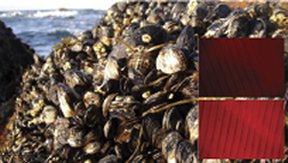Just as even the most seaworthy ship must steadily pump out bilgewater, cells continuously rid themselves of chemicals that don’t belong inside. The biological pumps that cells use for this purpose are among evolution’s oldest and most enduring inventions. They share nearly identical molecular machinery in organisms from bacteria to people.

So, when David Epel and Till Luckenbach recently discovered that the pumps falter in mollusk cells that have been exposed to some chemicals used as artificial fragrances, the Stanford University researchers became worried about more than the health of marine animals. Epel and Luckenbach suggest that people may face an elevated risk from pollutants whenever they apply to their bodies, or otherwise come in contact with, the artificial fragrances known as synthetic musks.
Because the new experiments tested excised gill tissue rather than living organisms, there’s no direct evidence that the fragrances cause harm in this way. Nevertheless, some researchers say that the findings have important implications in toxicology.
The Stanford results suggest that synthetic musks are “indirect toxicants,” says Christian Daughton of the Environmental Protection Agency laboratory in Las Vegas.
Synthetic musks aren’t limited to colognes described as having musk fragrances. Many perfumes, fragrant cosmetics, air fresheners, and cleaning products contain the chemicals.
At least some synthetic musks can harm organisms directly, but hazardous concentrations are considerably higher than those typically encountered in the environment.
However, past studies didn’t investigate the chemicals’ effects on the cellular bilge pumps, which scientists call efflux pumps, multidrug-resistance transporters, and various other names. These versatile transporters eject a wide array of toxins, drugs, and other compounds of natural or artificial origin. “They’re constantly pumping out the stuff the cell doesn’t want inside,” Daughton says.
These pumps protect health by reducing the exposure of cells to harmful chemicals, such as toxic metals, but they also enable both bacteria and tumor cells to become drug resistant.
Lingering odors
In the new study, conducted at Stanford’s Hopkins Marine Station in Pacific Grove, Calif., Epel and Luckenbach exposed patches of gill tissue from California mussels to solutions of seawater containing standard amounts of alcohol and a fluorescent red dye called rhodamine B. Some solutions also contained other chemicals from a list including half-a-dozen musks.
The researchers then washed the tissues in fresh seawater and then determined how much dye each sample pumped out of its cells. Musks are classified as nitromusks and polycyclic musks Two nitromusks, at concentrations of less than 1 micromole per liter (µM/l), suppressed by half the normal activity of the cells’ efflux pumps, Epel and Luckenbach report in the January Environmental Health Perspectives. Four polycyclic musks, at between 2.0 and 2.5 µM/l, also reduced pump activity by half. Mixing musks in a solution produced additive effects.
By comparison, a similar inhibitory effect required 0.1 and 1.6 µM/l of two drugs with known effects on pumps.
In other experiments, Epel and Luckenbach found that pump inhibition lingers after exposure to at least some of the chemicals. Even 24 hours after contact with the nitromusk called musk xylene or the polycyclic musks branded galaxolide and tonalide, mussel tissues absorbed and retained significantly more rhodamine B than usual. The pump-inhibiting drug verapamil exposure had lingering effects for at least 48 hours.
The researchers say that musks may stick to key portions of the efflux-pump molecules, effectively handcuffing them for a time.
The Fragrance Materials Association of the United States (FMA), a Washington, D.C.–based trade group, responded critically to the Stanford study. In a written statement, FMA pointed out that the concentrations of synthetic musks reported to inhibit efflux pumps are hundreds or thousands of times greater than concentrations in bodies of water in the environment.
In their report, Epel and Luckenbach acknowledge this, but they note that synthetic musks accumulate in aquatic organisms’ tissues, where they can reach concentrations more than 1,000 times those in the surrounding water.
FMA also says that the tissues used in the new study lacked important defense mechanisms, such as the layers of mucus that protect living mussels’ gills. “Extrapolating these observations in excised gill tissues of mussels to humans is highly speculative,” FMA states.
Ecotoxicologist Shannon Bard of Dalhousie University in Halifax, Nova Scotia, says the discovery of hours-long efflux inhibition suggests that brief exposure to musks and similar contaminants could usher in a period in which organisms are unusually susceptible to environmental poisons.
Because musks crop up in aquatic environments receiving multiple synthetic chemicals, Daughton says, the inhibitors may set up other environmental contaminants to do more harm than usual.







